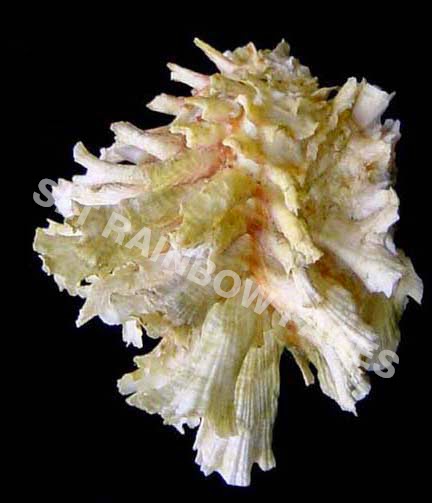Jewel box: Chama lazarus.
One of a number of species in the island and the most spectacular.
The hinge is greatly elongated, hence the shape.
Four other species of various sizes, usually attached to branching soft corals,
the smallest to a stinging hydroid. Same family as the pearl oysters.
Rock or Bombay oyster: Saccostrea cucullata.
A beautiful golden yellow and very tasty. The shell seen from the side. 45mm
The shell is shown from the top, with left and
right valves to either side. The black colour behind (below) is characteristic.
55mm
Scallops:
Chlamys spectabilis, Ch. irregularis, Unknown
species, Ch. senatorius (clockwise
from top).
Four out of a number of species of scallops in Sri Lankan waters.
Mostly small and not commercially fished
Two varieties of chanks are found around the coast. There is a large organised commercial fishery for these shells that are exported to the sub-continent for the manufacture of jewellery and ornaments. In life they are covered by a thick brown ‘skin’ – at left. In the rare valampuri the shell opening would be on the left of the shell. Up to 170mm.
This has a cylindrical shape with the long, narrow
opening on the underside as in all cowries. 80mm.
Abbas cone: Conus abbas.
Striate cone: Conus striatus. 90mm.
A pretty non-venomous cone. 50mm.
An uncommon cone with fine ridges around the outside
making it rough to touch. All cones have long, narrow openings at the side. 40mm.
Limpets: Cellana rota, Patelloida striata and Clypidina notata.
These three belong in three different families but often live clustered together in colonies. Some of the images are of the undersides—useful in identifying them. They are small – 10 to 25mm.
These four, out of the six, periwinkle species often cluster together, mostly above the tide line where they dry out at times. They are small, ranging from about 10 to 20mm in size.
A volute found off northern Sri Lanka and southern India growing to about 75mm. Rare.
Clover’s lyria: Voluta (Lyria) cloveriana.
Orange mouth spider conch: Lambis crocata.
One of a
group of sand bottom-dwelling carnivores that drill holes into bivalves and
suck out the flesh, this is the most spectacular. Growing to about 130mm in
length it has three rows of sharp, slender spines. Other species have fewer and
shorter spines.





















No comments:
Post a Comment